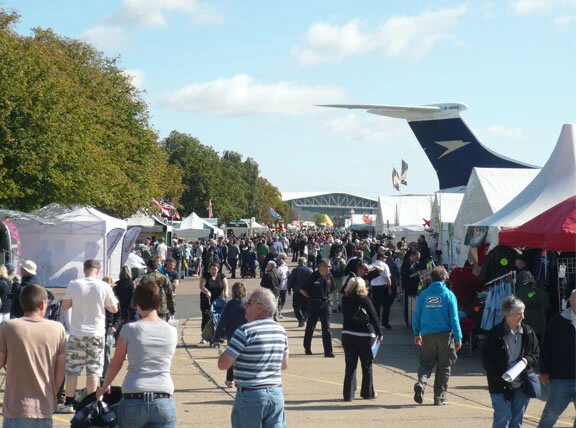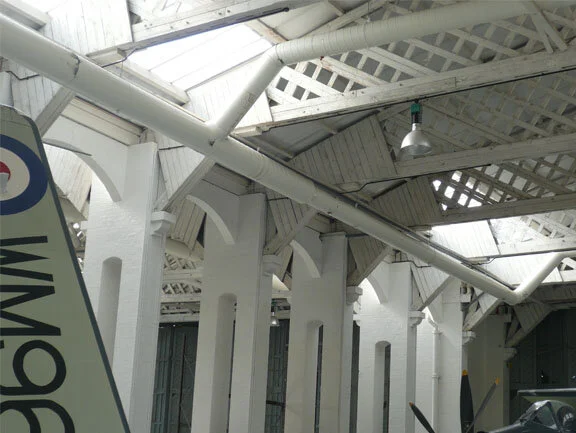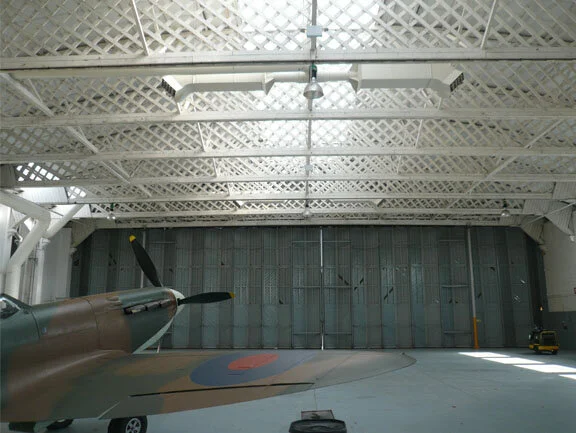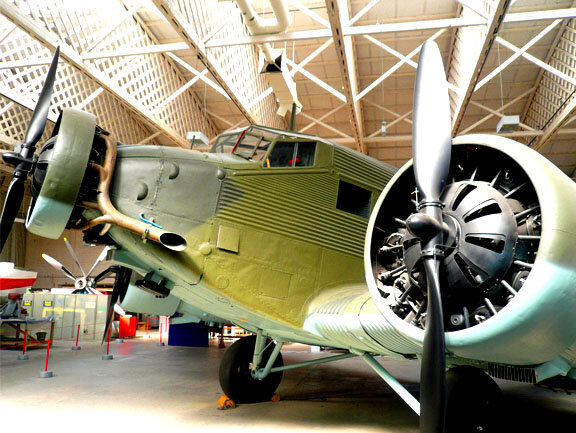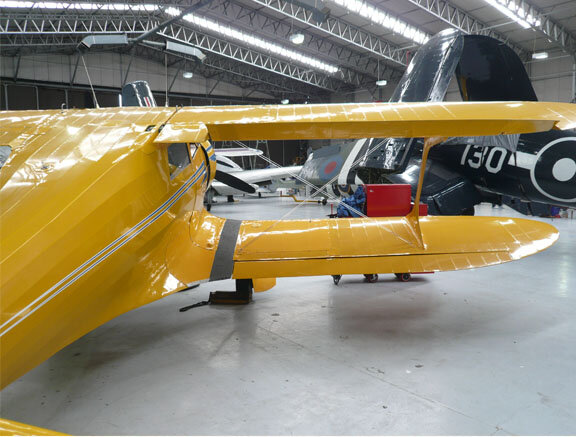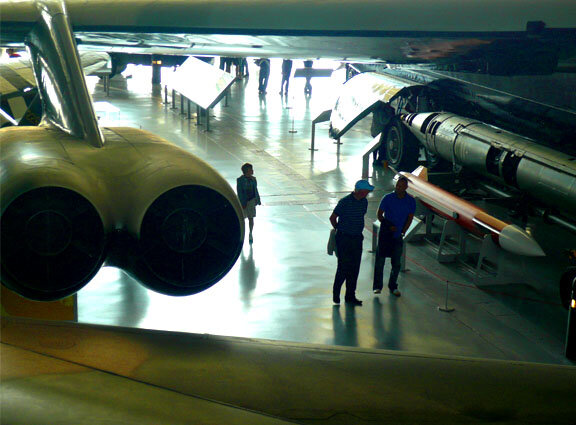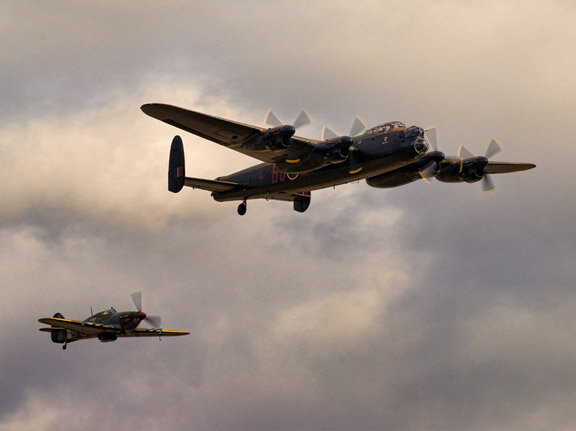DUX UNLIMITED
Several months ago, there was to be a foreign exchange of sorts at Vintage Wings of Canada. Howard and Peta Cook would come to Ottawa to fly and share the fun of the Classic Air Rallye with fellow Vintage Wingers. They would then depart for Suffolk, there to await the arrival of myself and my sweetheart Susan. We were to be hosted by them at the annual Duxford Air Show. Alas, Howard's immediate future would change drastically following his accident in the Tiger Moth prior to the Air Rallye. With serious injuries and a long recovery road ahead (which for some time being has detoured sharply away from Duxford - he has now returned to his home in Bury St. Edmunds, Suffolk), Howard would stay in Ottawa with Peta staying at our house.
Encouraged by both the Cooks and Mike Potter, we did not postpone our journey to the centre of the known vintage aviation universe. And I am glad beyond measure that we stayed the course and found ourselves in the warm embrace of Howard and Peta's "other" family.
On Saturday morning, we breakfasted on tea, toast and Seville marmalade at a grand country inn in Newmarket, Suffolk. Newmarket is to equinephiles what Duxford is to the aviation addict. Outside our window stood a line of stable windows with dark Arabians snuffling at the early autumn breeze and beyond their aristocratic mein stood circular tin-roofed exercise barns. Our early morning constitutional required us to not only dodge the mirrored chaos of left-handed traffic, but twenty-horse caravans of shiny thoroughbred flat racers being exercised on the high street by an army of tiny people in riding tuck. Ah... England. Beautiful beyond words, steeped in a brew of history and determination, ordered and constantly calm despite the spin of the roundabout and the hooligan boys at the pubs.
Our driver left us at the brown brick gatehouse of former RAF Duxford, now the site of the Imperial War Museum and a cadre of vintage warbird restorers and operators. For me, it was as though he had dropped us off in September of 1940. The red brick guard houses stood to the left and the right and before me, the dark rising wall of a First World War hangar... the still intact flight line of a former RAF fighter station. Duxford, once the site of the RAF's No.2 Flying Training School, became a fighter base in the early '20s, remaining that way until the 1960s - from the Avro 504 to the Gloster Javelin - from linen-covered, sputtering biplanes to the dark sinister blade of cold war paranoia.
Today would be my introduction to the world of Duxford and the finest vintage aircraft collectors, restorers and operators anywhere. Sent on a mission to seek out new ideas and explore possibilities, I was shaking with excitement. On any normal day, as I drive the last couple of kilometers to our own hangar in Gatineau, my nervous energy increases and my foot presses deeper on the accelerator, so one can only imagine my excitement at being so close to the motherload. Susan had to tell me to calm down on more than one occasion.
Gates opened at 9 AM at Duxford. This was the scene at 930 AM. The popularity of Duxford events is such that people stream in the gates from the get-go. The "main drag" at Duxford features scores of hobby shops, aviation art galleries, binocular and camera merchants, full motion flight simulators and booths for related aviation restoration groups. Flying displays did not start until 2 PM, so retailers did brisk business all day. Photo: Dave O'Malley
It was 9:30 AM and the gates had just opened, but already the crowds were so dense, it felt like we were filing out of church on a Sunday morning. Walking the flightline, hangars were banked on the left, while displays and swag merchants lined the right. It was a midway of sorts - high tech omni-max flight simulators, sweets merchants, militaria-mongers, art shops specializing in aircraft prints signed by the stars (Johnnie Johnson, Sailor Malan, Adolph Galland), toys, collector swag and charitable foundations.
The first thing you notice when at Duxford is the time allotted to just plain browsing and doddling. The air was excited but relaxed at the same time. There was plenty of time between the 9 AM opening and the 2 PM flying display - and people were making the best of it. At either end of the main hangar line stand two great museum halls belonging to the Imperial War Museum (love that name ... it sounds so grand and since it doesn't say which empire, it implies that there is no other). At one end is the sweeping arched cathedral of the American Air Museum, while the throngs are bookended at the other end by the Land Warfare Hall and the IWM AirSpace hall. In between are a collection of 4 First World War hangars housing a wide range of warbird restoration and operation activity. It blew my mind. The 2 o'clock start to the flying was upon us before I managed to get through half of it.
When the show started, I settled into a comfortable seat at a table with members of the Historic Aircraft Collection extended family with a plate of food and some wine and watched one of the finest flying shows anywhere. I thought there was nothing that could top this until I went to Old Worden's Shuttleworth Collection the following day, but that is another story.
Enough words. Let's let the photos do the talking. Having only a small pocket camera, my aircraft photography left much to be desired. Through Flickr, the web's premier photo sharing site, I contacted two Aviation Photographers who were there on the same day I was at Duxford. Both Andy Scrutton and Aaron Scott provided me with excellent images from that day to help tell the story. Let's get to it.
Much of what is special about Duxford lies in the intact wooden Belfast truss hangars of First World War vintage. These are listed buildings (meaning that in the UK they have preservation status - wish we could do this for the same vintage hangars at Borden). Vintage warbird operations like Howard's Historic Aircraft Collection, The Fighter Collection and others conduct restoration and maintenance on an eclectic collection of aircraft under the same composite trusses and masonry columns as did the men of the RFC in the First World War and the RAF during the Battle of Britain. Photo: Dave O'Malley
Related Stories
Click on image
Through the modern eye of a digital lens, we can see just how it would have appeared to maintainers as they readied a Spitfire inside the doors on the hangar line.
Tant Ju - A JU-52 Trimotor in exquisite condition tells us that this is indeed an eclectic collection. This aircraft is a license-built variant manufactured by the French Amiot Company. It served post war with the Portuguese Air Force, but is seen here in Luftwaffe markings for the Imperial War Museum. Photo: Dave O'Malley
Beneath the wing of a Fieseler Storch sits the delicate remains of a Japanese Mitsubishi Zero - the outer skin panels attached to a framework so that viewers could see her shape better. One wonders if she will some day be whole again - seeing the incredible work being done at Duxford, it's entirely possible. Photo: Dave O'Malley
The bizarre compaction and counter-rotating propellers of the Fairey Gannet AS-6 Anti-submarine and Patrol aircraft really gets your attention. A post war Royal Navy aircraft, from the tip of its nose to its triple tail, the Gannet was unique in every way. Powered by an Armstrong Siddley "Double Mamba" engine, the Gannet had all the over-water benefits of a twin engine aircraft, but none of the asymmetry problems associated with one engine shut down. Photo: Dave O'Malley
After seeing the Beaufighter at the Canada Aviation Museum languish for decades, it took my breath away to come upon one in the first hangar I visited. Once described as "a fuselage in hot pursuit of two engines", the "Beau" was the bane of shipping and coastal defences. It had a long career and served in almost all theatres of war in the Second World War, first as a night fighter, then as a fighter bomber and eventually replacing the Beaufort as a torpedo bomber. The unique layout of the engines gave it a pugilistic appearance - the propeller hubs being slightly ahead of the nose. This beauty belongs to The Fighter Collection. Photo: Dave O'Malley
Other than the colour of the Staggerwing, this could be a shot of our own hangar floor. This historic warbird has quite a history. Built as a UC-43B (military version of the Beech 17 Staggerwing) for the US Navy (serial 44-67724). It passed to the Royal Navy under Lend-Lease agreement becoming FT475 and operating from Scotland. Photo: Dave O'Malley
The centre of operations during events at Duxford is the Second World War vintage control tower. With Spitfires and Hurricanes lifting off the green grass in front of the tower, one could get a pretty good idea of what the scene might have been like during the Battle of Britain. Photo: Dave O'Malley
The Duxford flight line is bracketed on both sides by the major halls of the Imperial War Museum - the Imperial War Museum Air Space, the Land Warfare Hall and this American Air Museum dedicated to the USAAF and the USAF whose forces were stationed in Great Britain during the Second World War and the Cold War. The broad sweep of the roofline and the sheer wall of glass beckons visitors. Photo: Dave O'Malley
I found it compelling to note that the one aircraft that stands forward of them all is the Douglas C-47 Dakota, described by Churchill as one of the most important weapons of the Second World War along with the Atomic Bomb. Photo: Dave O'Malley
The place of honour in the American Air Museum is most clearly given to the Douglas C-42 Skytrain (DC-3 Dakota) where it will forever fly into the sun. Photo: Dave O'Malley
The great hall of the American Air Museum is stuffed with all the major aircraft of the USAAF and USAF over the past seven decades - here we see a B-24 Liberator, the C-47 Skytrain, a T-6 Texan, the tails of a B-52 Stratofortress and B-25 Mitchell, a U-2 and the stub wing of an A-10 Thunderbolt II (Warthog). Photo: Dave O'Malley
One aircraft dominates this hall above all others - both for its operational longevity and its immense size - the Boeing B-52 Stratofortress. Visitors are dwarfed by one of her 4 engine nacelles. Photo: Dave O'Malley
When you ponder one aircraft in the hall, you have many more in sight - here we see a Bell Huey, B-29 Super Fortress, B-52, B-25, C-47 Skytrain and an SR-71 Blackbird. Photo: Dave O'Malley
Spitfire Row - spectators could pay an extra fee to cross the fence line for a stroll along the flightline of participating aircraft - much like paddock passes during F-1 and NASCAR races. A close-up look and unobstructed camera angles of thoroughbreds like Spitfires, Buchons and Mustangs were privileges many were willing to pay for. This will undoubtedly be considered for our own Open House events, where presently we cordon off the "hot zone", limiting access to authorized people only. A short time before flying began, the flightline access wash stopped and the area cleared - a system that seemed to work perfectly. Photo: Dave O'Malley
Dave O'Malley presents Aircraft Restoration Company Spitfire pilot David "Rats" Ratcliffe with a Vintage Wings of Canada Hawk One Challenge Coin - a gift in return for his "spot-on" imitation of Douglas Bader's tin-legged walk. Also presented with a challenge coin was Bryan Simpson one of Historic Aircraft Collection's stalwart ground crew. An ambulance driver by trade, Simpson promised to "nick" an ambulance to meet Howard Cook upon his arrival home. The day started bright and sunny, but by show time the clouds had rolled in making for difficult photography. Photo: Susan Kirkpatrick
Throughout the entire day up until the 2PM show time, there was a steady turnaround of two Tiger Moths offering rides for paying customers. Judging by the constant flow for five hours prior to the show, many Englishmen will pay for the opportunity to fly back in time. Photo: Dave O'Malley
The legendary Charlie Brown of the Historic Aircraft Collection. Flt Lt Charlie Brown has been with HAC since 1996. Charlie has displayed many aircraft but is probably best known for his Spitfire and Me 109 displays. When not flying for HAC, Charlie is a flying instructor in the RAF, based at Cranwell. Photo: Dave O'Malley
For decades now, I have witnessed dozens of F-14, F-15, F-16, F-18 and A-10 demos here in Canada and the United States and after the 10th demo, they all seem to blur together. It was a real treat to see the Eurofighter Typhoon ripping through its spectacular routine - a sinister platform, a dark and foreboding sky, and a gut-churning series of turns and passes all combined to create a display like no other. Photo: Dave O'Malley
Streaming huge gouts of superheated air, the Typhoon rips through its routine. Photo: Aaron Scott
In addition to the boom 'n zoom jets and thundering warbirds, spectators feast on an eclectic assortment of classic aircraft - some flying in gaggles of dissimilar types - such as these four aerobatic classics - a Pitts Special, Nanchang CJ-4, Bucker Jungmann and a vintage Zlin. Photo: Dave O'Malley
One of the highlights of the day at Duxford was to spend a half hour chatting with Stephen Grey the founder of The Fighter Collection and one of the most accomplished vintage warbird pilots on the planet. And a charming rake I might add. Photo: Susan Kirkpatrick
Perhaps warbird perfectionists weep at the non-military bearing of this Hawker Hunter, but being from an air show and graphic design background, I can say I think it's breathtaking. Here, it jettisons the earth and screams for the sky overhead. The Hawker Hunter is one of the most beautiful first generation jet fighters of all time. Photo: Andy Scrutton
The Hunter Miss Demeanour comes across show centre lolligagging along with the canopy back. The mask must be for radio and fire safety, for there surely is enough oxygen at 50 feet. Photo: Andy Scrutton
The Hot Rod Hawker shares show centre with its American contemporary - an F-86A Sabre. Typical of many British aircraft designs of the day, the Hawker's fluid lines have an elegant piscine quality. Photo: Andy Scrutton
The stripes on this Sabre are Korean era squadron markings, and not Invasion stripes. This is the only airworthy F-86A in the world; it served in the USAF between Apr 1949 & Feb 1958. It was recovered from a Fresno scrapyard in 1970 by former P-51 pilot Ben Hall & restored, flying again in May 74 registered N68388. He kept it until 1990 when it was acquired by Golden Apple Ltd who did further work & in 1991 it won the Rolls-Royce/Warbirds Worldwide award for best jet restoration. It is based at Duxford with the Aircraft Restoration Company. Photo: Aaron Scott
The Battle of Britain Memorial Flight Lancaster and Hurricane make a dramatic pass against a darkening sky. I had the good fortine of seeing both of the world's only flying Lancs in the same two weeks. The BBMF Lanc at Duxford, the next day at Shuttleworth and then 13 days later, the Canadian Warplane Heritage Museum Lanc at our home base in Gatineau. Photo: Aaron Scott
Aviation photographer Aaron nails a perfect shot of the BBMF Lanc thundering into a storybook sky. Nice work. Photo: Aaron Scott
The breathtakingly beautiful and one-of a kind Hawker Demon I (G-BTVE / K8203) Following an 18 year restoration, this superb aircraft flew again on July 27th 2009. Only a month afterwards, it was burning up the sky at Duxford. A total of 305 Demons were built, 232 for the RAF. Photo: Andy Scrutton
One of the best things about Duxford and vintage aircraft operation throughout Britain is the plethora of one of a kind aircraft like this Percival P-6 Mew Gull. In all, six Percival P-6 Mew Gull aircraft were produced. Of these, only one - G-AEXF - survives, and that has been rebuilt twice - once in 1978 to its original factory specifications, and more recently, to its Cape Records configuration. The original Mew Gull was the first civil aircraft to exceed a speed of 200 miles per hour. Later versions introduced steady improvements, and the fastest speed recorded by G-AEXF in its 1938 Kings Cup configuration was in excess of 270 mph. At sea level, it was faster than a Hawker Hurricane. Photo: Andy Scrutton
Miles M.2L Hawk Speed Six, G-ADGP. Built in 1935 by the forerunner of the famous Miles Aircraft Co, this was a single seat racing aircraft and is the only remaining flying example of its type. Photo: Andy Scrutton
The Speed Hawk and the Mew Gull in a picture perfect pass - two lovely art deco masterpieces. Photo: Aaron Scott
The Bucker Jungmann shows off its considerable aerobatic capabilities. Photo: Andy Scrutton
Two Folland Gnats (G-TIMM and G-RORI) break against each other. This single seat fighter never saw service with the RAF, but it did serve with the Indian Air Force, and the Finnish Air Force. The RAF did take on the two seat trainer version in 1959. The Gnat became famous for the 'Yellowjacks' Display Team from the Central Flying School, which went on to become the Red Arrows in 1964. The Two-seat Gnat was retired from the RAF in 1974. Photo: Photo: Andy Scrutton
The Aircraft Restoration Company's Canadian-built Harvard 4 in Portuguese Air Force markings. The Harvard was flown by Anna Walker of the Historic Aircraft Collection. Photo: Andy Scrutton
Looking like a painting as much as a photograph, Aaron Scott captures a lovely shot of the famous European B-17 named Sally "B". She also wore on her right side, the markings of the famous Memphis Belle. Photo: Aaron Scott
A Spanish-built Merlin-powered Buchon, playing the part of the Bf-109 takes off to attack a Hurricane which is in the throes of a flying demonstration. Photo: Aaron Scott
Four Spitfires are "scrambled" to chase off the Messerschmitt-clone Buchon which has harried the lone Hurricane long enough. Photo: Aaron Scott
Like Canada's Snowbirds, the Red Arrows are a nine-plane formation. Photo: Aaron Scott
A full show by the Red Arrows left the Duxford sky looking like an abstract water colour. Photo: Aaron Scott
The Spitfire Vb of the Historic Aircraft Collection was flown by Charlie Brown at the Duxford Air Show this year. The Mark Vb is considered by most to be the gold standard for Spitfire aficionados. This airframe (BM597) flew in combat with a Polish squadron in the RAF during the Second World War, thus making it one of the most desirable Spitfires extant. Photo: Dave O'Malley
When it comes down to it, it is the boots on the ground, the dedicated volunteer ground crew members like Bryan Simpson of the Historic Aircraft collection, that make an organization what it is. An ambulance driver by trade, Bryan dedicates all his spare time to ensure that the aircraft and pilots have all they need to put on a safe and exciting display. Photo: Dave O'Malley



